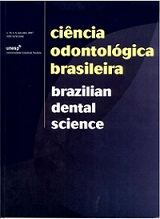Bond Strength of composite repairs using flowable or conventional resins or the association of both
DOI:
https://doi.org/10.14295/bds.2012.v15i4.855Resumo
Objectives: The aim of this in vitro study was to evaluate the effects of flowable resin as an intermediate agent on composite repairs on bond strength. Methods: Thirty truncated cones of Grandio SO (VOCO) were prepared and thermo-cycled for 5000 cycles for artificial aging. Specimen’s surface were sandblasted with aluminum oxide, cleaned with air/water spray and conditioned with phosphoric acid for 15s. After that, one coat of Admira Bond Adhesive (VOCO) was applied and light cured for 20s. Specimens were divided into 3 groups according to the repair material used (n= 10): Conventional Resin – Grandio SO (R), A thin layer of Flowable resin – Grandio SO Heavy Flow + conventional Resin (FR) and Flowable resin (F). Over the original specimens, a sectional cone-shape teflon matrix was hold in position , and the cones were built, according the groups described above. Another thirty specimens were built, 10 of each group, simulating a restoration without repair. Specimens were submitted to tensile stress in a universal testing machine. Data were recorded in MPa and evaluated with ANOVA, Tukey´ s and non-paired “t’’ tests. Results: ANOVA showed significant differences between groups which were performed repair (p< 0.00). The results of Tukey´ s test for these groups were: R (19.89 5.31)ab, F+R (14.49 5.59)a, F (20.91 3.99)b. The groups followed by the same letter did not show statistical differences. Non-paired “t” test showed that groups R and F repairs were similar of the correspondent groups which simulated a restoration without repair. Conclusions: The repair with conventional or flowable composite produced bond strength values similar to cohesive strength of the same materials. The use of a thin layer of flowable resin as an intermediate agent in composite repair decreased the bond strength when compared the same method for restoration.
Downloads
Downloads
Arquivos adicionais
Publicado
Como Citar
Edição
Seção
Licença
TRANSFERÊNCIA DE DIREITOS AUTORAIS E DECLARAÇÃO DE RESPONSABILIDADE
Toda a propriedade de direitos autorais do artigo "____________________________________________________________________" é transferido do autor(es) para a CIÊNCIA ODONTOLÓGICA BRASILEIRA, no caso do trabalho ser publicado. O artigo não foi publicado em outro lugar e não foi submetido simultaneamente para publicação em outra revista.
Vimos por meio deste, atestar que trabalho é original e não apresenta dados manipulados, fraude ou plágio. Fizemos contribuição científica significativa para o estudo e estamos cientes dos dados apresentados e de acordo com a versão final do artigo. Assumimos total responsabilidade pelos aspectos éticos do estudo.
Este texto deve ser impresso e assinado por todos os autores. A versão digitalizada deverá ser apresentada como arquivo suplementar durante o processo de submissão.




























